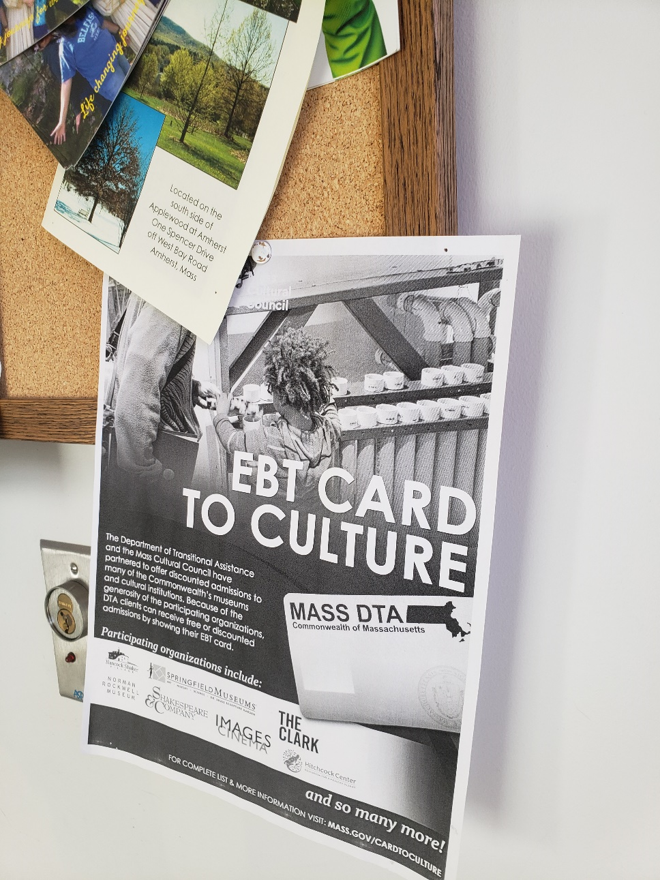03.03.2020
Create Welcoming, Inclusive Spaces
Kalyn King, Program Officer
Card to Culture
An EBT Card to Culture flyer on a bulletin board at The Hitchcock Center for the Environment.
Creating truly welcoming and inclusive cultural experiences goes beyond removing financial barriers to participation. It is an ongoing process of co-creation between cultural organizations and the populations they wish to serve. We recently hosted a webinar for organizations participating in our EBT Card to Culture and ConnectorCare Card to Culture programs with Sandra Bonnici, DAEI Consultant and AAM Senior Diversity Fellow for Facing Change. In it, we discussed techniques and best practices for creating a welcoming, inclusive experience for all visitors and especially those experiencing poverty:
VIDEO
As cultural organizations are working on overarching strategies to break down barriers to participation, here are a number of smaller, tactical steps you can take now to make your low-cost access programs more welcoming.
Don’t Ask Visitors for Additional ID Close Open “We tell people it is not necessary to show their card – we believe them.” – North Quabbin Garlic and Arts Festival.
Our Card to Culture program is built on “proof-showing” through the EBT, WIC, and ConnectorCare cards, and Mass Cultural Council requires participating organizations to train their staff to welcome these visitors. Yet, many families who would qualify for Card to Culture – or similar discounts – still choose not to use them for fear of having to disclose this information in front of their children or being treated differently for it. Having to prove low-income status with documentation (and especially additional ID) undermines the impact of these programs.
Consider how a belief in program abuse might be creating more barriers or a culture of judgment. Dispel the myth, and eliminate mistrust – rates of fraud are very low.
If you’re not asking for additional ID for other all other visitors, this deepens the “othering”.
For EBT and WIC programs, there is only one card issued per family, so the person visiting your organization may not be the head of household named on the card, but is still eligible to receive the discount.
Work Discount(s) into Online Ticketing Systems Close Open “I thank you for not making me feel embarrassed every time I purchased tickets through this program. It is truly appreciated. As with previous AAA discounts or such, sometimes it is difficult when living farther to drive and find parking twice versus by phone or online as an option.” – Visitor to The Zeiterion, in New Bedford.
There should be little to no difference in how EBT, WIC, and/or ConnectorCare cardholders are treated relative to other visitors. This includes the ability to purchase or reserve tickets through an online system or over the phone.
Online ticketing gives the visitor more agency and flexibility, rather than having to make multiple trips to your location in person to get a ticket.
Some organizations may select to have a discount code – i.e. “FREEC2C.” You may advertise this discount and code on your own website, or it can be shared less widely just on the partner agency’s website. All EBT cards start with the same six digits and can be checked virtually.
Provide Discounted Membership, Classes, Camps, or Workshops Beyond One-Time Admissions Close Open
Providing complementary or discounted membership is a way to decrease constant proof-showing.
Hand all of your visitors your membership brochure, the flier about birthday rentals, summer classes, etc.
Take special note of repeat visitors and consider how you can engage them more deeply in your work.
Removing the label from the ticket allows a person to visit your organization with a guest, or give the ticket as a gift, without having to disclose the reason they are eligible for a discount.
It also means proof-showing is only at the point of sale, rather than sale, entry, re-entry, etc.
Normalize the Experience, and Help All Visitors See Themselves at Your Organization Close Open
Is information about the discount easy to find on your website? “Admission & Discounts” etc.
Show images of the cards you accept for a discount at your admissions desk, and have fliers for the program(s) up. A visual indicator can also help overcome language barriers.
You can use the Card to Culture Communications and Signage Guide for some common language about the programs, images of the cards and logos, and examples from other participating organizations.
Flyers for the EBT , ConnectorCare and WIC Card to Culture partnerships are also available.
Additional Costs Associated with Visiting May Be Prohibitive, Even with Admission Discounts Close Open
Remember that your organization exists within a whole context – how someone finds out about your programming, how they get there, when they eat, etc.
Is public transit an option for visiting your organization? Is there free parking nearby? Bike racks? Specifying this type of information on your website can help visitors anticipate any additional costs of a trip.
Can you extend your Card to Culture discount to include concessions or parking costs?
Consider allowing visitors to bring their own food, and/or getting set up to accept EBT benefits for your food sales or farmers market on site. (Visit USDA and DTA ’s websites for more information.)
Belonging: Co-creating welcoming and equitable museums
Card to Culture
